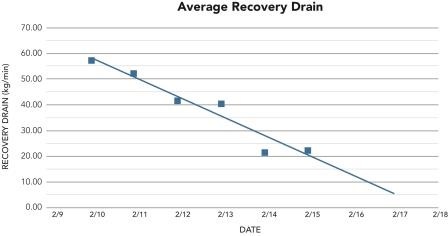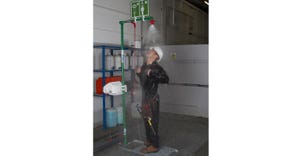Increasing Rotary Valve Life by Decreasing Wear
April 12, 2016

Rotary valves operate in the bulk solids material handling industry as airlocks and feeders simultaneously for facilitating continuous feeding into a differential pressure environment. They accomplish this by using rotating pockets inside a cast housing. In order to rotate freely, the rotor cannot be in contact with the housing or end plates. The necessary clearances, however, are cut to extremely tight tolerances in order to minimize air leakage from the higher to lower pressure side of the valve’s installation.
Issue Faced
As product passes through the valve, a small amount of the product and its dust are carried by what air leakage exists. This product can abrade and wear the surfaces of the housing and/or the rotor, gradually increasing the clearances from their beginning areas. As the clearances increase, so does the amount of air leakage and the wear issue increases at a compounding rate.
To guard against initial air leakage and wear, rotary valve manufacturers take great care to design valves with tight initial clearances. They also look at system design parameters that will allow the amount of differential pressure across the valve to be reduced, which also helps to prolong life. However, these options can only go so far to formulate an overall solution.
Another piece of the puzzle is to make the wear surfaces (rotor tips, end plates, housing) out of more abrasion-resistant materials. Most rotary valve housings and end plates are made of either cast iron or cast stainless steel. Rotors are standardly mate of carbon steel or stainless steel plate.
Historical Action
A cost-effective way of increasing abrasion resistance is to coat the interior surfaces of the valve with a more abrasion-resistant material, and/or make the rotor’s vane tips either out of a different material or coated/covered surface. Common materials used to perform these functions include chrome coatings used on the interior surfaces of the valve and end plates and AR hardened steel tips for the rotors. By coating the interior with chrome, the interior wear surfaces are increased in Burnell hardness from 200 to 750. By increasing the rotor tips from standard carbon steel plate to AR steel, their Brinell hardness is increased from 150 to 400. While it is important to remember that no change can completely eliminate wear, the combined effect of these changes can often prolong the life of the valve by a factor of two to three times what it would otherwise normally be.
Insufficiency
For many cases, the modifications described above are sufficient. In cases of extreme abrasion, either due to high differential pressure or highly abrasive materials, even more extraordinary steps may need to be taken.
Hypothesis for Resolution
Recently, an alternative wear design has been developed using ceramic tiles (Brinell hardness 900) on the valve’s interior wear surface and applying tungsten carbide (Brinell hardness 850) to the tips of the rotor. The hope was to provide longer life of valve service by increasing the abrasion resistance of the product contact construction.
Test Subject
A manufacturer of custom counters installed a dilute phase pneumatic convey system utilizing rotary valves to function as feeders and airlocks. The product going through the valves was over 99% crystalline silica. On the initial installation, rotary valves utilizing chrome-coated interior surface and AR hardened tips were used to help protect against wear.
Upon start-up of the system it was quickly evident that one of the valves in the system path was rapidly losing its tolerances. While wear in this extreme environment was expected -- and at some level accepted as a cost of doing business -- the speed of wear impact in this case exceeded the customer’s initial expectations. The result in cost of replacement and downtime was unsatisfactory to continued operation.
In a test of the hypothesis above, the valve was replaced with a valve of the same size with ceramic tiled interior surfaces and tungsten carbide wear tips. The resulting positive impact surpassed even initial expectations.
Description of System and Circumstances
The valve service was placed on the bottom of a reclaim filter bin on load cells. When the bin filled, the customer recirculated the material back to the process. As the bin was on load cells, the discharge rate out of the bins was measured in Kg/min.
As wear on the valves increased, and clearances opened, the discharge rate of the material from the bin would decrease. This was due to the increased updraft volume of air interfering with the product discharge into the bin, combined with the decrease in air going down the convey system causing pressure to trend up. These are typical symptoms of rotary valve wear on a feeder airlock to a dilute phase conveying system. When a new valve was installed, the system rate would typically operate near 50 kg/min. As the valve would operate and become exposed to wear, the rate would decrease. This would continue until the rate reached below 20 kg/min, at which point the valve would be changed from service and the cycle would repeat.
Data
Previously, when using rotary valves with chrome interior surfaces and abrasion-resistant tips, the valve in service would last between four to six working days. The graph below represents discharge rates in kg/min over the life of one valve:
The downward trend in service is marked and clearly defined.
The previous hypothesis was tested by placing a valve of the same size into the same service on the same material being conveyed. The graph below shows the service life and discharge rate over the next nine days:
While still producing an overall downward trend, the slope of the rate of wear was reduced dramatically.
Conclusion
While no valve can completely eliminate wear, the change in surface contact materials of construction brought about a significant reduction in the rate of wear. This means that the expectation of wear life in this valve has a reasonable chance of increasing a given application by a factor of seven.
By combining the reduced cost of frequency of replacement with increased productivity and reduced downtime, the more abrasion-resistant features provide an overall cost-efficient potential solution for extreme wear environments.
Larry S. Eagan is regional sales manager for Magnum Systems Inc., Kansas City KS. He has over 20 years of experience in dry bulk material handling systems, the last 15 with Magnum Systems. He has designed and sold hundreds of pneumatic conveying, packaging, and dust collection systems throughout the country. For more information, visit www.magnumsystems.com.
Get more information or register for the International Powder & Bulk Solids Conference & Exhibition, May 3-5, 2016
For related articles, news, and equipment reviews, visit our Valves, Gates, & Airlocks Equipment Zone
Click here for a List of Valve, Gate, & Airlock Manufacturers
You May Also Like


